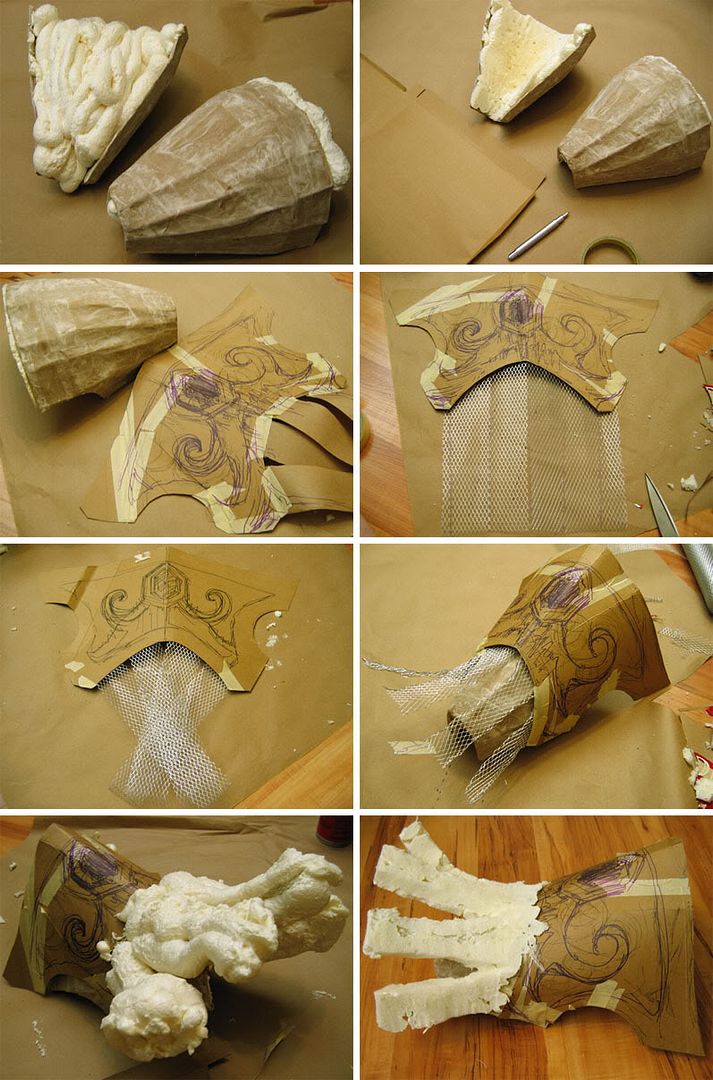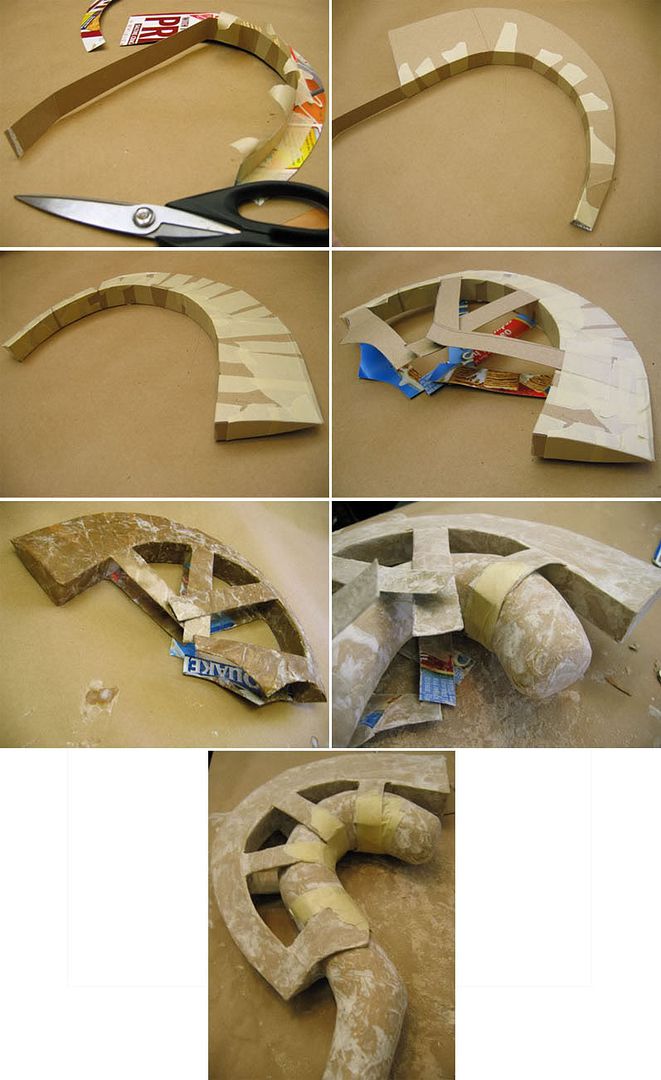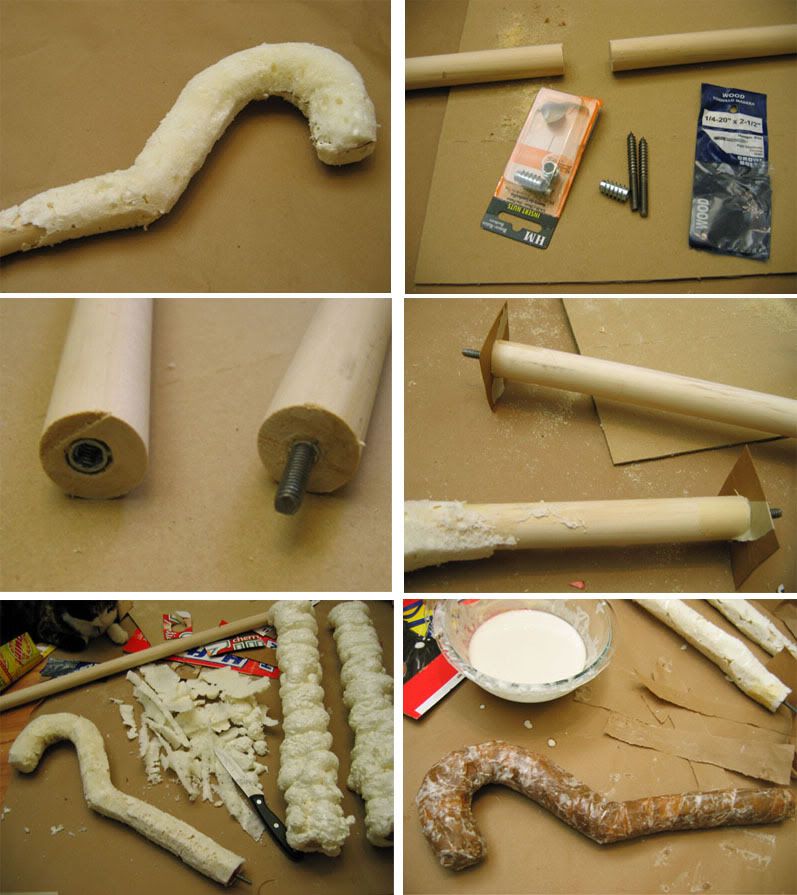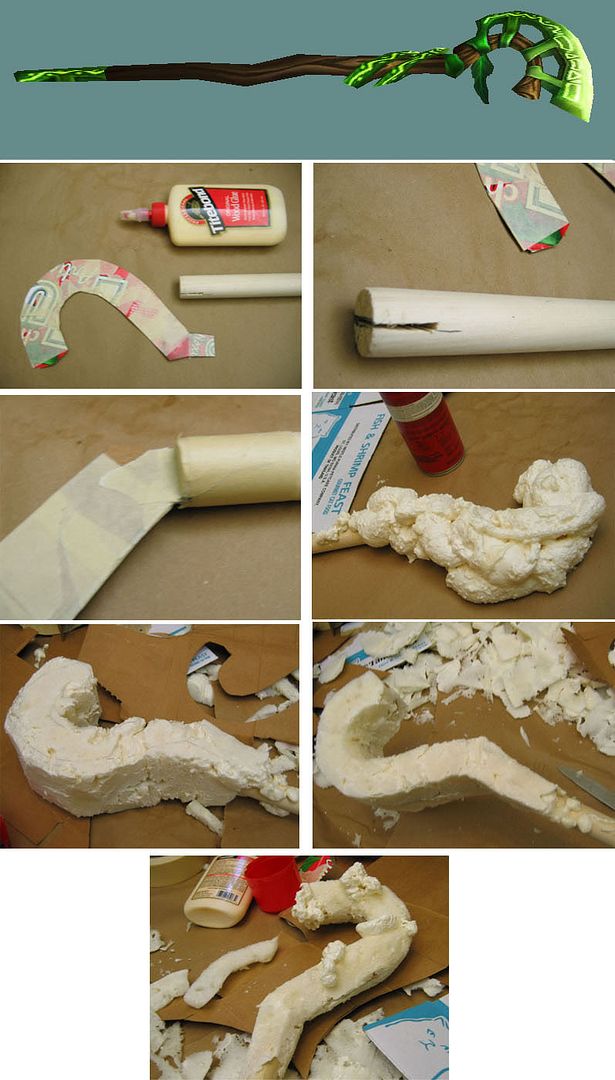 It's been another month since my last update, although I have been getting a lot done in the past week. The staff is finally finished! I may go back and add a leaf to hang with the straps, if I end up having time for that.
It's been another month since my last update, although I have been getting a lot done in the past week. The staff is finally finished! I may go back and add a leaf to hang with the straps, if I end up having time for that.
The straps are made of cotton strips that I sewed together to make tubes, which were ironed flat along the seams. They are attached by hand, and sewn to the unpainted green band.
The design is painted on with acrylic paint. I do not recommend painting acrylic onto cotton, it takes several coats and can be difficult to keep fluid and consistent.
There are fabric paints available at most craft stores, don't be a baddie like me.
==================================================================
The next big item I have to build is the shoulder armor. I am using a similar process as the staff - build it up with a foam base and cover in paper-mache.
 Here you can see them with the first layer. I'll have to go back over once or twice more just so there's enough to sand without going through to the foam underneath.
Here you can see them with the first layer. I'll have to go back over once or twice more just so there's enough to sand without going through to the foam underneath.
The raised area in the middle of each piece will have a gem inserted, with an LED and battery pack so it glows.
My first attempt at casting gemstones was Friday night, and they didn't turn out too badly considering the fact that the mold is made out of paper and tape. I used theproplady's resin gemmaking tutorial over on youtube, which are quite helpful. She has several videos about casting your own gems, so check them out!
The tape I used must have not been the right kind of plastic, or I must not have added enough catalyst into my resin mixture, because the resulting gems were still tacky after several hours drying.
 I used 400 grit wet/dry sandpaper to sand the gems in the hopes the left over tackiness will disappear. I will probably still need to use a plastic polish to hide the sandpaper scuffs and make the gems shine.
I used 400 grit wet/dry sandpaper to sand the gems in the hopes the left over tackiness will disappear. I will probably still need to use a plastic polish to hide the sandpaper scuffs and make the gems shine.
The large gem in the middle is the only one that has been sanded so far, the other two feel like Jolly Ranchers. Ick!
I may also end up re-casting them if I can get a decent mold out of either alginate or plaster-of-paris.
Making your own mold out of paper and tape is incredibly tedious and difficult to do well if you have difficulty making patterns for geometric shapes.
==================================================================
I started working on the ears I'll need to go with my costume. I could have bought a pair of ears and saved myself some time and effort, but this is something I've always wanted to try. They'll fit better this way, too (in theory).
 I found the How to make Hobbit Ears tutorial and have followed their instructions up to the sculpt step.
I found the How to make Hobbit Ears tutorial and have followed their instructions up to the sculpt step.
I used alginate mold material and plaster-of-paris mix from my local Dick Blick. Both have worked well so far, although the dental-grade alginate has been damp to the touch, even after it has hardened, like it sweats. I have no idea why the alginate does this.
Regardless, I was able to get nice plaster casts from the molds I made.
I cut two lengths of wire, one for each ear, and rigged a wire support/armature to build the modeling clay around. I will likely add a wire into each finished prosthetic ear, to keep them from sagging.
There is still a bit of work to do on sculpting the ears to my satisfaction and making them as symmetrical as possible, but they are fairly evenly proportioned and decent enough for about 5 hours of work.
There has been much painting over the last week, but the process has been slow-going due to high humidity (sidenote: there needs to be an acrylic paint that dries the same no matter the humidity *shakes fist* as I am tired of waiting 15-30 minutes between coats).
 I finished putting on the gesso primer and painting the base green for the staff ends, as well as adding most of the details. Looking back, the most challenging part of this was the gradient green-to-light-green on the crest. That was a royal pain, as I have not worked with acrylics seriously for about 6 years. Here are the results!
I finished putting on the gesso primer and painting the base green for the staff ends, as well as adding most of the details. Looking back, the most challenging part of this was the gradient green-to-light-green on the crest. That was a royal pain, as I have not worked with acrylics seriously for about 6 years. Here are the results!
The left image is a rough lay-in of where the gradient should be, and I worked with it for what seemed like hours until it was to my satisfaction.
The image on the right shows the top and bottom sections, the top with runes painted on (I may end up going back in to give them more depth; a carved-in appearance, but only if I end up with extra time) and the bottom before runes.
The bottom was much less of a headache because it did not require any difficult painting technique, just one solid color for each design.
 Here it is in all its wonderfully difficult to photograph glory!
Here it is in all its wonderfully difficult to photograph glory!
I still need to decide whether I want to paint the last green band on the staff's head and attach a feather separately, or attach a fabric band so I can include the feather that way. I also still need to sew the two fabric loops to attach on the head of the staff as well - but that requires fabric hunting - and that will need to wait for a few more weeks until I no longer require a boot on my nearly-healed foot.
Fortunately, the bulk of this prop is complete. I just need to finish up those tidbits and give it a nice matte clear coat and I can mark the Wildfury Greatstaff off the to-do list! I will be glad to have it finished so I can focus on the massive amount of work I have yet to complete before this costume is ready to be worn.
====================================================================
The next item up for construction is the Nordrassil Mantle, or the costume's shoulder armor. These will probably be the most time-consuming items I have to construct due to the nature of armor found in World of Warcraft (the bigger the shoulders, the more important the character - ha).
 I started with a cardboard base, cut and taped until I got a shape that fit the item's base model, and covered it in a few layers of paper mache. I then filled it with expanding insulation foam (so it would not just be hard cardboard against my shoulders. I may also add additional soft foam later if they end up being too hard still, or uncomfortable). Once the foam had dried, I cut away most of the underside.
I started with a cardboard base, cut and taped until I got a shape that fit the item's base model, and covered it in a few layers of paper mache. I then filled it with expanding insulation foam (so it would not just be hard cardboard against my shoulders. I may also add additional soft foam later if they end up being too hard still, or uncomfortable). Once the foam had dried, I cut away most of the underside.
The most time consuming part of this, so far, was making the pattern for the top. Patterns might take a while to get right, but they go a long way toward making your costume awesome. A bad pattern will ruin a costume, promise.
Once all the patterning was done and to my liking, I got out the wire mesh. This item is very easy to find in art stores and craft stores, I got mine at Dick Blick. You -can- use the stuff found at stores like Home Depot, but the craft variety is just as expensive, and a heck of a lot easier to work with. I used my crappy scissors to cut the mesh; Please do not use fabric scissors or nice scissors with this stuff - it will make nicks in the blades and turn them into garbage scissors. I bent the sides over to give it shape (and so my fingers would get stabbed less).
Cue the expandy-foam, yet again, and you end up with something Cthulhu would likely be proud of (yeah, it's that scary).
After it was completely dried I got out my knife and carved the foam to look like my reference image. The best part about using wire mesh with the expanding foam is that if you get to it before the foam is rock-hard you can still bend it! And so I did, since the prongs weren't looking exactly the way I wanted.
I'd like to thank masking tape, who has been awesome today, for keeping things where they need to stay and even playing nice with foam. You are the best friend a girl can have.. well, almost.
I have been steamrolling right along on this staff, and I am glad to say that the major construction portion is complete! There has been much frustration over getting the faux wood grain to look realistic (because, yes, everything must be perfect and I am a masochist - my back can vouch for that one). Fortunately, I have had success with this endeavor, and have moved on to painting the green top portion of the staff. There was much rejoicing. I pre-mix my (acrylic) colors in recycled tubs - lids are your best friend if you plan to reuse a mixed color. I will be using the same paint on other pieces, so I mixed a lot of paint. I ended up using 4 different browns to get a wood grain I liked. There were two medium tone browns for the base and basic grain layout, one light honey brown for the highlights and a black-brown for added texture illusion.I used a mixture of wet and dry brush techniques. Fortunately, I spent my college career in the art and theater departments/classes so I have a lot of experience with painting. This helped immensely, although I know that anyone with enough patience and determination can achieve a nice faux wood grain.
I pre-mix my (acrylic) colors in recycled tubs - lids are your best friend if you plan to reuse a mixed color. I will be using the same paint on other pieces, so I mixed a lot of paint. I ended up using 4 different browns to get a wood grain I liked. There were two medium tone browns for the base and basic grain layout, one light honey brown for the highlights and a black-brown for added texture illusion.I used a mixture of wet and dry brush techniques. Fortunately, I spent my college career in the art and theater departments/classes so I have a lot of experience with painting. This helped immensely, although I know that anyone with enough patience and determination can achieve a nice faux wood grain.
The key here is following the brush's lead - don't try to force patterns that the brush isn't interested in executing. It is especially important for 3D projects! The surface isn't flat, it is usually much easier and looks much better if you just put on some good music and go with the flow.I started with the darker of the two base colors, waited for it to dry, added another layer (the gesso shows through if your paint isn't very opaque), and then started using the side of my brush to lay in the lines. I repeated with highlights, added some medium brown back in where the highlights stood out too much, then went in with the dark brown last to give it some depth. Another important thing to keep in mind when painting faux wood grain is that you should try to avoid going over highlights with your darker colors. Ideally you want to put darker colors next to the highlights in order to give the texture the illusion of depth. Once all the wood was painted on I went back over the mess with gesso where I needed to paint in the green, so I would not need as many layers of green paint to cover the wood grain. Currently the crest is painted green all around and tomorrow or the next day it should be getting the shading and pattern painted on.
I swear, I'm not dead. I just broke my foot, so progress on the staff was stalled for about a week. I left off with adding layers of paper mache to the staff, and that's where I continued for another good one or two days (If you happen to be in a dry area, you will have greater success doing more layers of paper mache, but I'm in Illinois and summer gets decently humid so I only got about one each day).
Once the layers dry completely, it's time for the fun - sanding! I bought three different weights: 100, 150, and 200. I spent a lot of time sanding, and it does make quite a mess, so I was sure to put down a large sheet of paper to catch the dust. I did all of my sanding by hand, as most of the spots are not accessible with an electric sander.
 If you remember the reference image, there is an attached crest portion at the head of the staff. I wanted it to be lightweight but sturdy, so I used leftover soda case cardboard and masking tape to construct the crest.I cut out the basic shape and taped a smaller strip of cardboard along the underside. To keep the rigidity of the shape I cut pieces fit to each end and attached them securely with masking tape. Tape is your best friend!
If you remember the reference image, there is an attached crest portion at the head of the staff. I wanted it to be lightweight but sturdy, so I used leftover soda case cardboard and masking tape to construct the crest.I cut out the basic shape and taped a smaller strip of cardboard along the underside. To keep the rigidity of the shape I cut pieces fit to each end and attached them securely with masking tape. Tape is your best friend!
Once the shape was to my liking I added the tabs (that I later use to attach the crest to the staff head) and went through the paper mache process yet again. After everything was dry I trimmed down the tabs and taped the crest in place on the staff.
I bet you can't guess what comes next.. if you guessed paper mache you'd be correct! Oh yes. I am up to my eyeballs in paper strips and flour-paste. The cats love it - they chase the paper all around the house and try to eat the paste when I'm not looking, much to my frustration.
 More layers of paper mache are placed on the staff to cover the tape and keep everything stuck together. Once that task has been completed, the next step is more sanding. It is important to make a smooth surface for painting on later in the process, so I was sure to be thorough with my sanding.
More layers of paper mache are placed on the staff to cover the tape and keep everything stuck together. Once that task has been completed, the next step is more sanding. It is important to make a smooth surface for painting on later in the process, so I was sure to be thorough with my sanding.
Once the staff was free of paper mache lines and creases, and shaped to my liking, I went back and cut through the joints. For ease of use while building and attaching the crest, I didn't cover over the joints until after I had attached the pieces. Finding the right place to cut through was half guess and half luck; I'm going to say I was rather lucky on this front. I did miss the first time, but since I used a very thin blade, the spot in which I attempted to locate the metal screw is not very noticeable. I had very few rough edges from using such a thin blade, but I did one pass with a fine grain sandpaper to make sure I had not missed anything.
That is where I left off until this afternoon. Today I am in the process of priming the staff to be painted.
 Before I started, I sanded the staff once more time for good measure. One thing to be careful of, however, is over-sanding. If you sand too much, you risk pulling up a layer or layers of paper. I had a couple small spots with this, but they were easily trimmed off and sanded smooth.
Before I started, I sanded the staff once more time for good measure. One thing to be careful of, however, is over-sanding. If you sand too much, you risk pulling up a layer or layers of paper. I had a couple small spots with this, but they were easily trimmed off and sanded smooth.
After the surface looked smooth and free of rips, wrinkles, or tears I got out the gesso.
For anyone who is wondering what the heck gesso is; Gesso is a painting supply which can be found at most art stores. It is basically a primer. One does not necessarily NEED gesso, but it is definitely recommended. It gives a nice solid base on which to paint and it helps to keep some paints from bleeding through. I am not sure how well the paints I plan to use will work on paper mache as a base, so I opt to use gesso.
That is all the progress I have to share at this point, but I do hope to start painting soon. The staff will probably end up with two coats of gesso before it gets any paint.
I have been blazing right along with the construction on this project.Yesterday  I left off with filling in air bubbles.
I left off with filling in air bubbles.
The next step is to decide the length of each segment. I am flying out to Blizzcon, so my props and costumes need to fit into my luggage. The standard for carry-on luggage is 45 linear inches, and I know my suitcase is 21 inches in length, so each section is approximately 20 inches without hardware.Once everything has been measured I cut and sand the edges, then drill pilot holes for my bolt hangers and insert nuts. These will be used to attach the sections into one whole, sturdy piece.After the hardware is installed, I glue cardboard platforms onto the ends to keep foam from covering my connectors. I cut these into the desired shape, they are useful as a guide while carving as well as a way to keep your hardware from getting covered with foam.
The next step is to paper-mache over the foam base. I used brown butcher paper torn into strips with 3/4 cup flour and about 1 cup water for the paste. Be sure to only do one layer at a time, and try not to have too much overlap. You must let each layer dry completely before moving on to the next, or your project will risk molding and becoming ruined.
I am still in the process of adding layers of paper-mache. It is a slow process, I recommend putting a movie on or listening to a sweet playlist while you work!
Here are some progress pictures of my Wildfury Greatstaff.
 I started with a cardboard base for the curved shape of the staff head. One piece of thin cardboard was not enough, so I attached another with masking tape.
I started with a cardboard base for the curved shape of the staff head. One piece of thin cardboard was not enough, so I attached another with masking tape.
The staff needs to be sturdy, so I cut into the dowel rod with a dremel tool and a hand saw to get a notch deep enough to put the tab into. I secured it with wood glue and put more masking tape on to reinforce the base.
Next is the fun part - I used HILTI expanding insulation foam to cover each side of the template. Note: wait for the foam to dry and harden completely before you turn it over to spray the other side.
Once the foam is completely dry and hardened, you can begin carving the basic shape. I started off with flat surfaces and then carved into that to give the top a rounded look. I want it to look like the curved section is part of the dowel rod, so I was careful to keep them around the same size.
The foam ended up with a few air bubbles, so I went back and filled in the empty spots. Once that is dry I will carve back down to the correct shape and move on to the handle of the staff. As you can see in the reference image at the top, the handle is not straight, so I will be using the insulation foam to imitate the structure.
Welcome to my blog! I'd like to start off with an introduction. My name is Rachel, I am 26 years old and live in the United States. I have always had an interest in costuming, but this is my first foray into cosplay - and where better to start off than Blizzcon 2010!?
I will be keeping track of my work and progress here, and I hope that the information and photos will be helpful to others interested is using similar methods to construct costumes and props.
If you have any questions about any of my methods or materials, feel free to leave a comment.
And with that out of the way, off we go!

 It's been another month since my last update, although I have been getting a lot done in the past week. The staff is finally finished! I may go back and add a leaf to hang with the straps, if I end up having time for that.
It's been another month since my last update, although I have been getting a lot done in the past week. The staff is finally finished! I may go back and add a leaf to hang with the straps, if I end up having time for that.  Here you can see them with the first layer. I'll have to go back over once or twice more just so there's enough to sand without going through to the foam underneath.
Here you can see them with the first layer. I'll have to go back over once or twice more just so there's enough to sand without going through to the foam underneath.  I used 400 grit wet/dry sandpaper to sand the gems in the hopes the left over tackiness will disappear. I will probably still need to use a plastic polish to hide the sandpaper scuffs and make the gems shine.
I used 400 grit wet/dry sandpaper to sand the gems in the hopes the left over tackiness will disappear. I will probably still need to use a plastic polish to hide the sandpaper scuffs and make the gems shine. I found the How to make Hobbit Ears tutorial and have followed their instructions up to the sculpt step.
I found the How to make Hobbit Ears tutorial and have followed their instructions up to the sculpt step.









